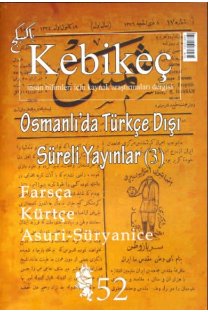Marya’nın Şikâyeti: Taciz mi Mezhep Değiştirme mi? 18. Yüzyıl Ankarası’nda Katolik Ermeniler
Marya’s Complaint: Sexual Assault or Conversion? Catholic Armenians in Eighteenth-century Ankara
___
- Ankara Kadı Sicili, defter no: 124
- Beydilli, Kemal. II. Mahmut Devrinde Katolik Ermeni Cemaati ve Kilisesinin Tanınması (1830).
- Cambridge, Massachusetts: The Department of Near Eastern Languages and Civilizations, Harvard University, 1995.
- Dadyan, Saro. Osmanlı’da Ermeni Aristokrasisi. İstanbul: Everest Yayınları, 2011.
- Erim, Neşe. “Osmanlı İmparatorluğu’nda Kalebendlik Cezası ve Suçların Sınıflandırılması Üzerine Bir Deneme.” Osmanlı Araştırmaları, no. 4 (1984): 79-88.
- Farès, Bichr. “‘Ird.” Encyclopaedia of Islam, Second Edition, der. P. Bearman, Th. Bianquis, C. E. Bosworth, E. van Donzel ve W. P. Heinrichs. Brill Online, 2008.
- Faroqhi, Suraiya. The Ottoman Empire and the World around It. London; New York: I. B. Tauris, 2004.
- -----. Stories of Ottoman Men and Women: Establishing Status, Establishing Control. İstanbul: Eren, 2002.
- Frazee, Charles A. Catholics and Sultans: The Church and the Ottoman Empire, 1453-1923. London; New York: Cambridge University Press, 1983.
- Ghobrial, John-Paul A. “The Secret Life of Elias of Babylon and the Uses of Global Microhistory “. Past and Present 222 (February 2014): 51-93.
- Ginio, Eyal. “The Administration of Criminal Justice in Ottoman Selanik (Salonica) During the Eighteenth Century.” Turcica 31 (1999): 185-209.
- -----. “Coping with the State’s Agents “from Below”: Petitions, Legal Appeal, and the Sultan’s Justice in Ottoman Legal Practice.” Popular Protest and Political Participation in the Ottoman Empire: Studies in Honor of Suraiya Faroqhi, der. Eleni Gara, M. Erdem Kabadayi ve Christoph K. Neumann, 41-56. İstanbul: İstanbul Bilgi Üniversitesi, 2011.
- Heyberger, Bernard. “Les chrétiens d’Alep (Syrie) à Travers les récits des conversions des missionnaires Carmes Déchaux (1657-1681).” Mélanges de l’Ecole française de Rome 100 (1988): 461-99.
- -----. Les chrétiens du Proche-Orient au temps de la réforme catholique: Syrie, Liban, Palestine, XVIIIe siècles. Bibliothèque des écoles françaises d’Athènes et de Rome. Roma: Ecole française de Rome, 1994.
- Karakoç, Sarkis. Külliyât-ı Kavânîn. haz. M. Âkif Aydin. 1. Cilt, Ankara: Türk Tarih Kurumu Yayınları, 2006.
- Kévorkian, Raymond H. “Giriş: Ankara’daki Ermeni Mevcudiyeti Üzerine Birkaç Tarihsel Not.” Sessizliğin Sesi - III : Ankaralı Ermeniler Konuşuyor, haz. M. Ferda Balancar. İstanbul: Hrant Dink Vakfı Yayınları, 2013.
- Meninski, Franciscus à Mesgnien. Thesaurus Linguarum Orientalium Turcicae-Arabicae-Persicae (Lexicon Turcico-Arabico-Persicum). Haz. Stanislaw Stachowski ve Mehmet Ölmez. İstanbul: Simurg 2000.
- Nirenberg, David. Communities of Violence: Persecution of Minorities in the Middle Ages. Princeton, N. J.: Princeton University Press, 1996.
- -----. “Conversion, Sex, and Segregation: Jews and Christians in Medieval Spain.” The American Historical Review 107, no. 4 (Oct 2002 2002): 1065-93.
- Ohanjanyan, Anna. “Gēorg Mxlayim Ōłli: An Overlooked Agent of Armenian Apostolic Confession-Building in Ottoman Constantinople.” Entangled Confessionalizations? Dialogic Perspectives on Politics of Piety and Community Building in the Ottoman Empire, 15th-18th Centuries, der. Tijana Krstic ve Derin Terzioglu. New Jersey: Gorgias Press, yayım aşamasında.
- Santus, Cesare. “Şeyhülislam Feyzullah Efendi and the Armenian Patriarch Awetik: A Case of Entangled Confessional Disciplining?” Entangled Confessionalizations? Dialogic Perspectives on Politics of Piety and Community Building in the Ottoman Empire, 15th-18th Centuries, der. Tijana Krstic ve Derin Terzioglu. New Jersey: Gorgias Press, yayım aşamasında.
- Tramontana, Felicita. Passages of Faith: Conversion in Palestinian Villages (17th Century). Göttinger Orientforschungen Reihe 1, Syriaca. Wiesbaden: Harrassowitz Verlag, 2014.
- Tuğ, Başak. Politics of Honor in Ottoman Anatolia: Sexual Violence and Socio-Legal Surveillance in the Eighteenth Century. Leiden; Boston: Brill, 2017.
- Zarinebaf-Shahr, Fariba. “Women, Law and Imperial Justice in Ottoman Istanbul in the Late Seventeenth Century.” Women, the Family, and Divorce Laws in Islamic History, der. Amira ElAzhary Sonbol, 81-95. Syracuse, N.Y.: Syracuse University Press, 1996.
- ISSN: 1300-2864
- Yayın Aralığı: 2
- Başlangıç: 1995
- Yayıncı: Mehtap Yüksel
Marya’nın Şikâyeti: Taciz mi Mezhep Değiştirme mi? 18. Yüzyıl Ankarası’nda Katolik Ermeniler
Sürgündeki Arnavutların Sesi: Vardar Gazetesi
Meydan “Sol”da Bir Şiir Dergisi (Ankara-Mayıs/1948)
Bulgarların Rehberliğine Soyunan Bir Gazete: Sıvetnik (1863-1865)
Bulgarca Süreli Yayıncılığa Dair Bazı Notlar
Kendine Ait Bir Girişim: Osmanlı Topraklarında 20. Yüzyıl Başında Yunan Kadın Editörler
Anagnostopoulou CHRYSOULA, Kudret EMİROĞLU
1903-1904 Avusturya-Macaristan Konsolosluk Raporlarına Göre Arnavut Basını ve Ulusal Kimlik
Petrika GAVRİ, Nathalie CLAYER
Bulgarlar Arasında Katolik Propagandası Yapan Bir Gazete: Bılgariya (1859-1863)
